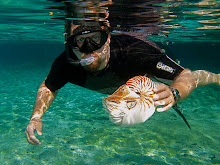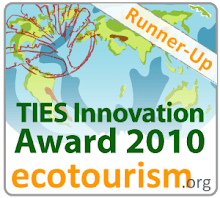
One important part of our ecotourism programs to
Midway Atoll is at least a 1/2 day spent giving back to Midway. Our visitors seem to relish in taking part in the "new" battle for Midway. Since
Oceanic Society started bringing visitors to Midway way back in 1996, we have always tried to help the Fish and Wildlife Service in their efforts at habitat restoration. Over the years our volunteers have helped to "restore," I mean "pull weeds" at many different sites on Sand and Eastern Island. FWS has a master plan directed at how to try and combat the many invasive plant species that have found their way to Midway Atoll. On Sand Island alone over 240 non-native plant species exist. When you realize that if we could restore

Midway to its original state (before people were living on the islands) there would only be about 37 native plants species that would/should be found there. That leaves about 200 species that are trying to out compete native species! While some may enjoy the various hibiscus and plumeria that are found on Sand Island it is the more insidious invasive species that are presenting the FWS with such a habitat restoration challenge. Species like lantana, Castor bean, and ironwood take major efforts to control. But the real thorn in the side of this endeavor is a plant called Golden crown-beard or
Verbesina encelioides. "Verbesina" as it is called on the island is what most of our

eco-volunteers spend their service afternoon battling. This desert adapted plant loves the sandy soil and disturbed ground conditions it finds at Midway. Add abundant rain during most of the year and this plant just takes off, growing in thick fields and sometimes getting to heights over 6-ft.!
One of the main reasons that invasive species are so bad on the island is that they tend to not offer the advantages to the resident seabird species nesting, that native plants do. For instance native grasses grow in bunches allowing for good air flow around nesting seabirds, helping to insure that they, and their chicks do not get overheated. Native ground covers work to both hold the sandy soil in place but at the same time not getting so dense as to inhibit burrowing seabirds from digging into the ground. Invasive species like Verbesina are bad by growing so thick they block wind flow (albatross nesting areas in Verbesina can be 10 degrees (F) hotter than the same type of nesting area with native grasses), and worse, the roots are so shallow that burrowing birds can burrow, but eventually many of the burrows will collapse, trapping adults or chicks inside. So much of the effort directed at invasive species control on Midway is to restore habitat to help enhance success of native seabirds that are nesting on Midway atoll.

Everything from Laysan Albatross, to Red-footed Boobies, to Christmas Shearwaters

benefit from the efforts of FWS and eco-volunteers to remove invasive flora and replant native species. These two pictures above show just how effective these efforts can be. They are both taken at the same location one year apart. The first picture shows our April '08 group out-planting bunch grass in an area that has a history of Verbesina control. The second picture taken this past April '09, and shows what that area and what the outplanted bunch grass (Eragrostis variabilis) looks like one year later. It is truly amazing how quickly these areas can be restored through regular weeding and outplantings. All of our service activities related to habitat restoration are under the guidance of FWS "weed combatant" extraordinaire
Greg Schubert, who oversees the native plant propagation, habitat restoration, and weed control efforts at Midway Atoll. In January and February 2009 alone, Greg directed and participated in the out-planting of over 2000 native plants on Midway. His efforts to return to these outplanted areas on a regular basis, selectively controlling the invasives before they can reestablish, are an on-going management plan that is methodically and effectively restoring many acres of seabird habitat. Although I said these areas are quickly restored, that term is relative when you consider his 5 year commitment to this effort, and the fact that many more years, and volunteer efforts will be needed to see all of Midway's invasive species removed, or at least controlled.
Weeding also helps to open up space for nesting seabirds. This can be even more important when you are trying to opening up habitat area for endangered seabirds in efforts to have them recover historic breeding sites.

Since 2001 Midway Atoll has utilized
Short-tailed Albatross decoys to attempt to attract the Golden Goonies to once again nest on Midway's islands. On Eastern Island about 25 "fancy" decoys are placed out each year. Here is a picture from that first year when the plot was weeded to make sure that any passing Short-tailed Albatross would be sure to spot the brightly painted decoys. Short-tailed albatross recorded calls are also employed at the decoy site. This idea was conceived by
Stephen Kress who has used the combination of brightly colored decoys and recordings successfully with
puffins on rock islands in Maine. 8 years later the decoys and sound system seem to be working. Recently, an adult and sub-adult have been seen dancing at the decoy site.

It is hoped that over the next few years Midway may see its first successful Short-tailed albatross nest in over 40 years! Thanks to the multi-year efforts of dedicated FWS employees and volunteers, hundreds of extra eco-volunteer hours, and original thinkers like Stephen Kress the new battle of Midway is slowly being won. Even though the Vebesina is still thick in many places, and other "bad" plant species like wild poinsettia and sandbur will create new problems, the current efforts of Greg and his crew are gaining ground. These small advances may seem to take forever for us, but for the seabirds that call these islands home, (and even those who are struggling to recover a home they once had) the ongoing habitat restoration efforts continue to help their populations recover from years of exploitation and decline at the hands of man.
 Short-tailed Albatross at decoy plot 2008
Short-tailed Albatross at decoy plot 2008
 Prior to the group leaving for Palau the class was given a series of lectures from their teacher, Tina Champagne, the Oceanic Society biologist (and blogger), Wayne Sentman, and Educational Technologies, Harvard University Extension School Master's Candidate, Alisyn Johnson. The students came up with ideas to help facilitate their two weeks without red meat and get more individuals to participate, one student even had her family cat join in with the pilot program! The school was extremely supportive where the kitchen lunch staff helped the students by offering special lunch options for the participating students during the two week period.
Prior to the group leaving for Palau the class was given a series of lectures from their teacher, Tina Champagne, the Oceanic Society biologist (and blogger), Wayne Sentman, and Educational Technologies, Harvard University Extension School Master's Candidate, Alisyn Johnson. The students came up with ideas to help facilitate their two weeks without red meat and get more individuals to participate, one student even had her family cat join in with the pilot program! The school was extremely supportive where the kitchen lunch staff helped the students by offering special lunch options for the participating students during the two week period.









































